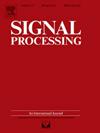A hybrid perceptron with cross-domain transferability towards active steady-state non-line-of-sight imaging
IF 3.4
2区 工程技术
Q2 ENGINEERING, ELECTRICAL & ELECTRONIC
引用次数: 0
Abstract
Active steady-state non-line-of-sight (NLOS) imaging entails the acquisition and processing of continuous multi-bounce NLOS signals to facilitate the recovery of hidden scenes. Recently, learning-based methods have demonstrated competitive performance in NLOS imaging. However, most of them inadequately capture the underlying features inherent in acquired signals and fail to effectively exploit prior information from hidden scenes, thus constraining their ability to alleviate the ill-posedness. To address the above limitations, we propose a novel NLOS signal processing framework—hybrid perceptron with cross-domain transferability (HP-CDT). The HP enhances the utilization of primitive features through a hierarchical pooling and feature fusion (HPFI) mechanism while comprehensively capturing underlying correlations within the signals via local and global perception. Besides, it facilitates cross-level interactions and fusion of various features, thereby enriching the feature representation. The cross-domain transfer (CDT) strategy leverages line-of-sight (LOS) latent representations as priors to steer the NLOS feature extraction, facilitating the optimization of NLOS latent representations. Rendering experiments and practical assessment indicate that, compared with existing methods, our approach achieves superior imaging quality while maintaining a light-weight architecture for efficient deployment.

面向主动稳态非视距成像的具有跨域可转移性的混合感知器
主动稳态非视距成像(NLOS)需要采集和处理连续的多反弹NLOS信号,以促进隐藏场景的恢复。最近,基于学习的方法在NLOS成像中表现出了竞争力。然而,它们大多不能充分捕捉到所获取信号的内在特征,不能有效地利用隐藏场景的先验信息,从而限制了它们缓解不适的能力。为了解决上述限制,我们提出了一种新的NLOS信号处理框架-具有跨域可转移性的混合感知器(HP-CDT)。HP通过层次池化和特征融合(HPFI)机制增强了原始特征的利用,同时通过局部和全局感知全面捕获信号中的潜在相关性。此外,它还促进了各种特征的跨层交互和融合,从而丰富了特征表示。跨域转移(CDT)策略利用视距(LOS)潜在表征作为先验来引导NLOS特征提取,促进了NLOS潜在表征的优化。渲染实验和实际评估表明,与现有方法相比,我们的方法在保持轻量级架构以实现高效部署的同时,获得了卓越的成像质量。
本文章由计算机程序翻译,如有差异,请以英文原文为准。
求助全文
约1分钟内获得全文
求助全文
来源期刊

Signal Processing
工程技术-工程:电子与电气
CiteScore
9.20
自引率
9.10%
发文量
309
审稿时长
41 days
期刊介绍:
Signal Processing incorporates all aspects of the theory and practice of signal processing. It features original research work, tutorial and review articles, and accounts of practical developments. It is intended for a rapid dissemination of knowledge and experience to engineers and scientists working in the research, development or practical application of signal processing.
Subject areas covered by the journal include: Signal Theory; Stochastic Processes; Detection and Estimation; Spectral Analysis; Filtering; Signal Processing Systems; Software Developments; Image Processing; Pattern Recognition; Optical Signal Processing; Digital Signal Processing; Multi-dimensional Signal Processing; Communication Signal Processing; Biomedical Signal Processing; Geophysical and Astrophysical Signal Processing; Earth Resources Signal Processing; Acoustic and Vibration Signal Processing; Data Processing; Remote Sensing; Signal Processing Technology; Radar Signal Processing; Sonar Signal Processing; Industrial Applications; New Applications.
 求助内容:
求助内容: 应助结果提醒方式:
应助结果提醒方式:


